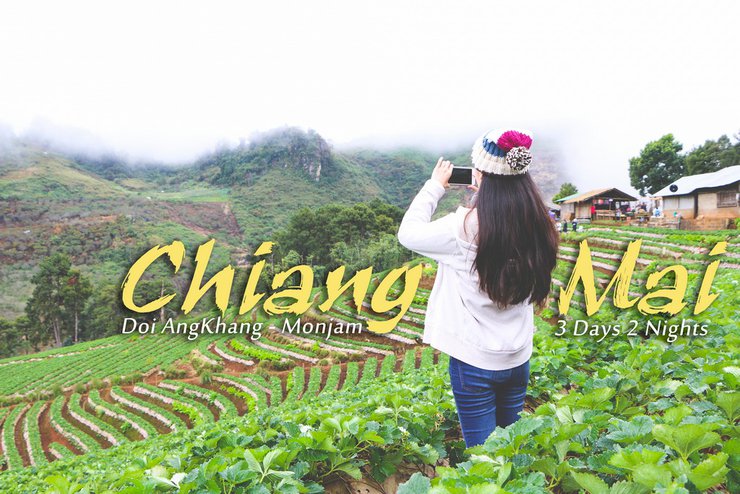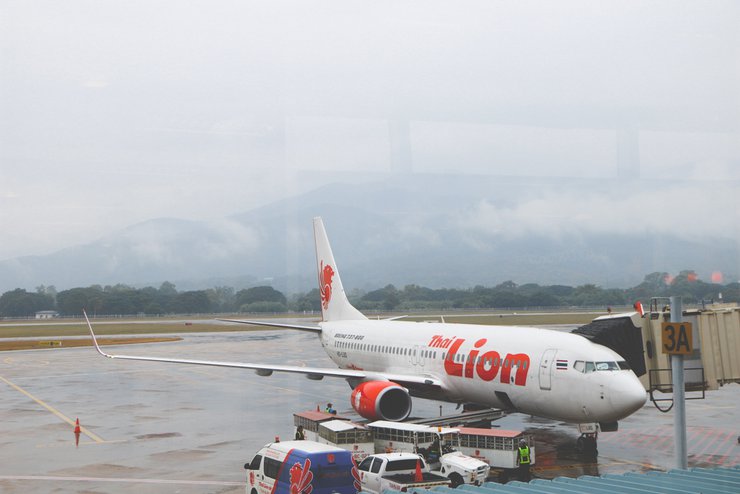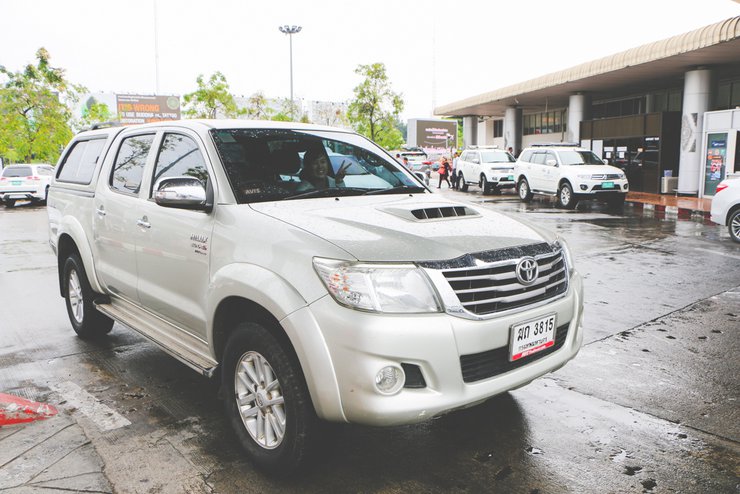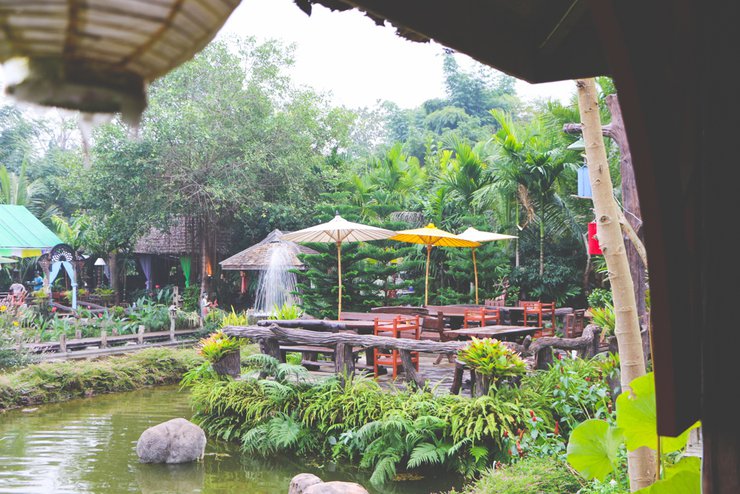The first province in the north that comes to mind when you want to experience nature and cold weather is which province? Our first province is Chiang Mai, a province with a wide variety of tourist attractions. No matter how many times you visit, you will never get tired of it. It has become a regular trip that you must visit Chiang Mai every year. This time, we have a total of 3 days and 2 nights with two destinations in mind, Doi Ang Khang and Mon Cham. Where can we take our girlfriend to visit? Follow me.

DAY 1
Upon our arrival, intermittent showers and a chilly atmosphere created a damp, yet pleasant, sensation.

For this trip, we rented a car in advance, but it was a bit last minute so we were only left with this pickup truck. It protected us from the sun, rain, and cold throughout the entire trip.

Once ready, the journey begins with the first stop being a lunch break at Saneh Doi Luang Restaurant, located on the bypass road of Chiang Dao District. The travel time is approximately 1 hour and 30 minutes.

The restaurant boasts a Lanna-style decor, and on clear days, offers stunning views of Doi Luang Chiang Dao.

After lunch, we continued our journey in the midst of the drizzling rain. From Chiang Dao district, there are two routes to Doi Ang Khang. The first route (gray line) is Chiang Dao district - Fang district, a distance of approximately 90 kilometers. The last 5 kilometers of this route are uphill, which are quite steep to very steep. This route is not suitable for people who are not confident in driving or are not familiar with the route, especially during rain or heavy fog.

The second route (blue line) is from Chiang Dao District to Ban Arunothai, covering approximately 90 kilometers. This route is not steep but has many curves. We chose the second route because it is easy to drive and the scenery along the way is beautiful.

The final 20 kilometers of the journey involved an uphill climb. On that particular day, the fog was extremely dense, and it became even thicker as we ascended. At times, visibility was limited to just 3 meters, making the drive quite hazardous. As a result, we were only able to maintain a speed of 20-40 kilometers per hour.

The journey from Chiang Dao to Ang Khang typically takes around 1.5 hours, but on this particular day, it took us 2.5 hours. Despite the delay, we arrived safely at our accommodation for the night, "Ang Khang Nature Resort".

After checking in and settling into our accommodation, we drove out for dinner near the Ang Khang Royal Agricultural Station, which was not far from our lodging. We opted for Ting Ting Restaurant, known for its signature dishes like pork knuckle and Yunnan steamed buns.

and shiitake mushrooms braised in soy sauce

After finishing their meal, they took a short walk to browse the shops. However, most stores were already closing due to the low number of customers and the cold weather.

This is our room for tonight. It is very spacious and comes equipped with all the necessary amenities. The floor is carpeted, except for the area in front of the bathroom.

The highlight of our stay was the heated bed with adjustable temperature. It kept us warm and cozy all night long, making it hard to get out of bed in the morning. This feature was perfect for us, as we are both prone to feeling cold.

The bathroom was not a place I wanted to spend much time in, unless absolutely necessary. It was extremely cold, with only the water heater and hairdryer providing any warmth. Everything else was freezing, even the toilet seat, which was so cold that I had to hover to use it. Fortunately, the hotel provided cloth slippers that I could wear around the room to keep my feet warm.

DAY 2
The next morning, I planned to watch the sunrise over the sea of fog at Mon Son viewpoint. However, when I arrived, the atmosphere was filled with fog, and I couldn't see the sun at all. I could only wander around in the fog, but it was beautiful in its own way.

After waiting for nearly an hour for the fog to clear, we returned to the hotel for breakfast.

The restaurant is located next to the lobby, offering both indoor and outdoor seating.

Initially, we sat outside due to the pleasant atmosphere and scenic view. However, we were unable to withstand the mist and relocated indoors.

The hotel offers a wide variety of dishes in a standard format. However, what sets it apart is the use of fresh vegetables and fruits sourced from the Royal Project. The freshness is evident in every bite, especially in the stir-fried cabbage with fish sauce, which is remarkably crisp and flavorful.

Another favorite is the toast with a wide variety of jams to choose from, such as strawberry, longan, lychee, kiwi, or peach. My personal favorite is longan.

After finishing our meal, we went for a walk around the hotel to take photos. Several cherry blossom trees were in full bloom, showcasing their beauty near our room.

The morning mist is quite thick, making the cherry blossoms soaked with water. Small birds are flying in to drink nectar excitedly.

Packed clothes into the bag, checked out, and continued the journey to the strawberry farm at Ban Nor Lae.

Driving through the mist, we soon arrived at the strawberry farm. This photo was taken from the view behind the parking lot.

The morning mist has cleared, revealing the strawberry fields. Let's go take some pictures.

Visitors are permitted to take photos in the strawberry field up to five levels, reaching the fence that the locals have set up.

Picking strawberries without permission is strictly prohibited. However, there are no strawberries to pick anyway, as local villagers have already harvested them for the Royal Project since early morning. Only small, unripe berries or flowers remain.

To ensure safety, visitors should tread cautiously due to the narrow and slippery pathways. This precaution prevents accidental falls that could damage nearby vegetable plots.

As we were taking photos, a large bank of fog rolled in, obscuring the strawberry field from view. We sought shelter in a nearby villager's home, where we purchased some handcrafted souvenirs.

The path is teeming with giant earthworms, wriggling aimlessly. They seem to be moving erratically, sometimes forward, sometimes backward. Some unfortunate creatures have met their demise, crushed by passing vehicles.

The photo of these two squirrels with wide eyes was taken by a person on their way back from a strawberry farm. They opened the window and pressed the shutter button just once, and the squirrels ran away into the forest. She was especially proud of this photo because she was able to take it just before they ran away.

From the strawberry farm, drive back a short distance and turn into the Khop Dong village. Park at the school in front of the "Sen Silp" shop, a souvenir and handicraft shop selling student-made tribal crafts. Proceeds go towards student scholarships.

Most products are made from natural materials such as sacred grass, which is believed by the Lahu people to protect against danger. These materials are used to create jewelry such as bracelets, necklaces, hairpins, and keychains.

The Khop Dong Village is another spot to enjoy the sunrise and the sea of mist. However, today the mist was too thick, making it difficult to see anything clearly.

The weather is cold. I'd better go home and sleep. The dog said so.

From the Khop Dong village, we continue to the 2000 Rai Tea Plantation.

The 2000 Rai Tea Plantation is another popular spot for taking photos of the thin sea of fog floating above the tea plantation. However, today the fog has drifted elsewhere.

The atmosphere here is pleasant, the air is fresh, and the view is beautiful. However, parking is limited and the road is a dead end, requiring drivers to reverse back the way they came. The road is also quite narrow, which could be inconvenient during peak seasons. It is recommended to park at the tea sorting factory and walk down to the location.

After visiting the tea plantations, we drove back to the Agricultural Station in Ang Khang for lunch. We ended up at a restaurant serving tom yum noodle soup.

After lunch, we drove into the Angkhang Royal Agricultural Station.

The first stop is near the helicopter landing pad, where villagers offer pony rides to tourists. There is also a plum orchard nearby.

The next stop is the 80th Anniversary Garden, also known as the 80th Birthday Anniversary Garden. This garden showcases a diverse collection of cold-climate plants and flowers, offering visitors a delightful experience for both sightseeing and photography.


Notably, cherry blossom trees from Japan and Taiwan have been blooming since early December and will continue to bloom until January.



Opposite Garden 80 is a Royal Project shop, which sells souvenirs, gifts, and products sourced from local villagers.


Fresh strawberries from local farms are also sold here.

"A cup of coffee, a postcard, to someone" is the slogan of this shop.


The next step is to collect and cultivate plum varieties.

The plum blossoms bloom between December and January, making it an ideal time to visit for photography.




The final stop at Angkhang Royal Agricultural Station is the ornamental cabbage field.

Translate rose

and the adjacent souvenir shop.

We then continued our journey to return to Mon Cham for the night, which was approximately 162 kilometers away and took about 3.5 hours.

Tonight, we are staying at the Hmong Hilltribe Lodge Resort, located near Mon Cham, a popular tourist destination in Chiang Mai province.

Every evening around 8 pm, after a satisfying dinner, the hotel hosts a cultural performance showcasing the traditional arts, games, and way of life of the Hmong people, an indigenous tribe residing in the vicinity of the resort. This performance serves as a warm welcome to guests staying at the hotel.

This is another significant highlight and a unique feature of the hotel. Image source: www.hmonghilltribeLodge.com

All rooms are designed in a fusion style of Hmong village and loft, decorated with natural materials such as woven bamboo covering the concrete walls, and roofs made of vetiver grass. Warm orange lighting is used to create a cozy atmosphere.

The interior features a spacious central hall that leads to four smaller rooms. Our accommodation comprises three Superior rooms and one Deluxe room.

The Superior room we stayed in had two beds, adorned with bedspreads and curtains woven from Hmong-patterned cotton.

Amenities include a fan, heater, tea and coffee making facilities, a kettle, and a refrigerator.

The accommodation does not have air conditioning as the weather is cool year-round. Additionally, there are no televisions or Wi-Fi in the rooms to encourage guests to fully immerse themselves in the peaceful natural surroundings. Wi-Fi is available in the dining area.

Two extra blankets were provided, which were very useful as the weather was very cold. Two blankets were warm and comfortable.

The bathroom area is clearly divided into separate shower, sink, and toilet rooms.

The bathroom features a rain shower with a water heater, and provides shower gel and shampoo.

Opposite the bathroom is the toilet.

DAY 3
The next morning, I woke up to the refreshing and cool air, surrounded by lush greenery.

As the light broke, we realized we were nestled amidst mountains veiled in wispy mist, surrounded by trees of all sizes.

The accommodation zone consists of three large houses with a spacious courtyard in the center. The courtyard features seating and a bonfire pit, creating a warm and inviting atmosphere for guests to gather, relax, and enjoy conversations around the fire.

The fresh air and pleasant atmosphere are perfect for an early morning walk to breathe in the clean air. Let's explore the accommodation together.

The restaurant has two zones: an indoor zone for breakfast and dinner on rainy or foggy days.


The second zone will be an outdoor area near the swimming pool and bar, with a side view of the rice terraces and mountains. This area is ideal for dinner.

A large swimming pool is located next to the rice terraces and mountains.

Wooden benches are available for visitors to relax and enjoy the view, making it a truly captivating experience.


If it weren't for the cold weather, I would go for a swim.




Adjacent to the swimming pool is the Standard room zone, which comprises approximately 6-7 buildings. Each building houses 4 guest rooms.



The house at the very end next to the rice terraces was empty, so we asked the staff for permission to explore the interior to share with our viewers.



Each room features a private balcony with bamboo chairs for relaxation.

This is the main entrance to the house.

Upon entering the door, one is greeted by a large hall that serves as a living room. In the center, a bonfire crackles, with a ventilation shaft situated above.


Ideal for families or groups of friends seeking a private space for socializing.

The interior design of the room will be similar to the Superior and Deluxe rooms, but the size of the room will be smaller.


A lampshade with a Hmong hat would be a lovely addition.

We appreciate this room because the headboard is positioned directly beneath a window that offers a breathtaking view of the mountains and the cascading rice terraces.



The amenities are the same as the other room types.


The bathroom has separate areas for the sink, shower, and toilet, but the space is smaller than other types of bathrooms.



After a short walk, I started to feel hungry, so I went to the dining room for breakfast. There was a wide variety of food to choose from, including both Thai and Western cuisine.


Our favorite menu is the clay pot chicken rice, served piping hot with a rich and flavorful broth.


After finishing our meal, we returned to pack our belongings in preparation for check-out. We then took a moment to explore the Deluxe room adjacent to ours.

The room is spacious and magnificent. It features a large single bed.

Decorated in the Hmong style, similar to other room types.

The room features a small bed and an outdoor balcony for relaxation.


Fully furnished (excluding TV, Wi-Fi, and air conditioning).


The bathroom is spacious and features distinct functional areas.


We unanimously agree that we adore this place. The resort's ambiance, enveloped by nature and fresh air, the warm decor, the friendly staff, and most importantly, the utmost privacy and tranquility, make it an ideal retreat to unwind and disconnect from the hustle and bustle of the outside world.

After packing our belongings and checking out, we continued our journey to Mon Thawan and Mon Cham, which are approximately 4 kilometers away from our accommodation.

The first stop was Mon Thawan viewpoint, which we reached by car around 1 pm. Despite the heavy fog, the atmosphere was still very pleasant.




Lost in the joy of photography, our eyes began to hunger. We decided to have lunch at Mon Cham, parking our car below and walking up about 500 meters.

Nestled atop Mon Cham, the Nong Hoi Royal Project Development Center's restaurant caters to tourists with two seating options. The first option features long tables arranged side-by-side on the upper level of the restaurant building.

The second section consists of a row of wooden huts perched on the edge of a cliff. The front offers a view of the mountains and the sea of mist, but today the mist is so thick that nothing can be seen.

To order food, customers must go upstairs and place their orders. A staff member will then bring the food to their table. While waiting, a local resident will greet them.

And he moved to sleep on our laps. He must be cold, so he came to find a warm place to sleep.

The food ranged in price from tens to hundreds of baht. We ordered three dishes, two plates of rice, and drinks, which came to around 300 baht.

After recharging, they went out to take photos and have fun.








We spent about an hour here before heading back to Chiang Mai city.


They visited the Ang Kaew Reservoir within Chiang Mai University, reminiscing about their early courtship days.

Before taking Taklom to her favorite restaurant, Sukishi Chang Phuak, the branch behind CMU, the restaurant she always begs to eat at every time she visits Chiang Mai.

With a dry sukiyaki menu, add a lot of glass noodles, her favorite menu. Seeing this small size, but very full. I once ordered 2 bowls to eat alone.

After a satisfying meal, we rushed to the airport to return the rental car and check in for our flight. The holiday season brought a surge in passengers, causing heavy traffic that nearly made us miss our flight. Thankfully, we arrived home safely, filled with unforgettable memories. Despite our familiarity with Chiang Mai, its charm never ceases to amaze us, leaving us hopelessly smitten with its allure.

The Doi Ang Khang - Mon Cham route is considered another romantic route full of nature and fresh air. It is suitable for taking your lover to relax, take pictures with flowers, and experience the cold weather. You can travel within 3 days and 2 nights. Here is a summary of the travel details.
Day 1
- Arrive at Chiang Mai Airport.
- Rent a car and drive to Doi Ang Khang, approximately 160 km away, taking about 3 hours (excluding stops). There are two routes: Chiang Mai - Chiang Dao - Fang and Chiang Mai - Chiang Dao - Ban Arunothai. Both routes are similar in distance, but the Ban Arunothai route is recommended as it is less steep and easier to drive.
- Spend the first night at "Ang Khang Nature Resort" (Highlight: Heated bed with adjustable temperature).
- Enjoy dinner at Ting Ting Restaurant (Highlight: Pork leg with mantou, braised shiitake mushrooms).
- Visit the Ang Khang Walking Street (Highlight: Hot milk).
Day 2 Itinerary:
Morning:
- Witness the breathtaking sunrise and mist-covered mountains at Mon Son Viewpoint (weather permitting).
- Visit Ban Nor Lae Strawberry Farm and savor the sweet, juicy berries.
- Explore Rai Cha 2000, a picturesque tea plantation with stunning views.
Afternoon:
- Immerse yourself in the serene beauty of Ang Khang Royal Agricultural Station.
- Marvel at the vibrant cherry blossoms at the 80th Anniversary Garden and discover the diverse plum varieties in the collection orchard.
- Return to Mon Cham for a relaxing afternoon.
Evening:
- Settle into your cozy accommodation at Mong Hilltribe Lodge, nestled amidst the tranquility of nature.
- Enjoy a captivating performance of traditional Hmong music and dance.
Contact Information:
- Website: https://www.hmonghilltribelodge.com/
- Facebook: https://www.facebook.com/HmongHilltribeLodge/
DAY 3
1. Enjoy the panoramic view of the sea of mist at Mon Thawan.
2. Have lunch at Mon Cham (Highlight: Enjoy your meal in a hut on the cliff edge).
3. Take in the breathtaking views and capture stunning photos at Mon Cham (Highlight: Poppy flower field).
4. Travel back to Chiang Mai city.
5. Relax and unwind at Ang Kaew Reservoir, Chiang Mai University.
6. Savor a delicious dinner at Sukishi Chang Phuak, the branch behind Chiang Mai University (Highlight: Dry sukiyaki).
7. Depart from Chiang Mai Airport and head back home.
There is still about a month left this year to experience the cold weather. Plus, during this time, the Dok Phaya Suea Krong, or Thai cherry blossoms, should be in full bloom. Beg your partner to take you until they give in. If you want to go, you must go.
Thick eyebrows & round eyes
Love is a journey | Because love is a journey...
Follow our journey at: LOVE IS A JOURNEY
LOVE & LIFE IS A JOURNEY
Friday, October 4, 2024 3:10 PM






















